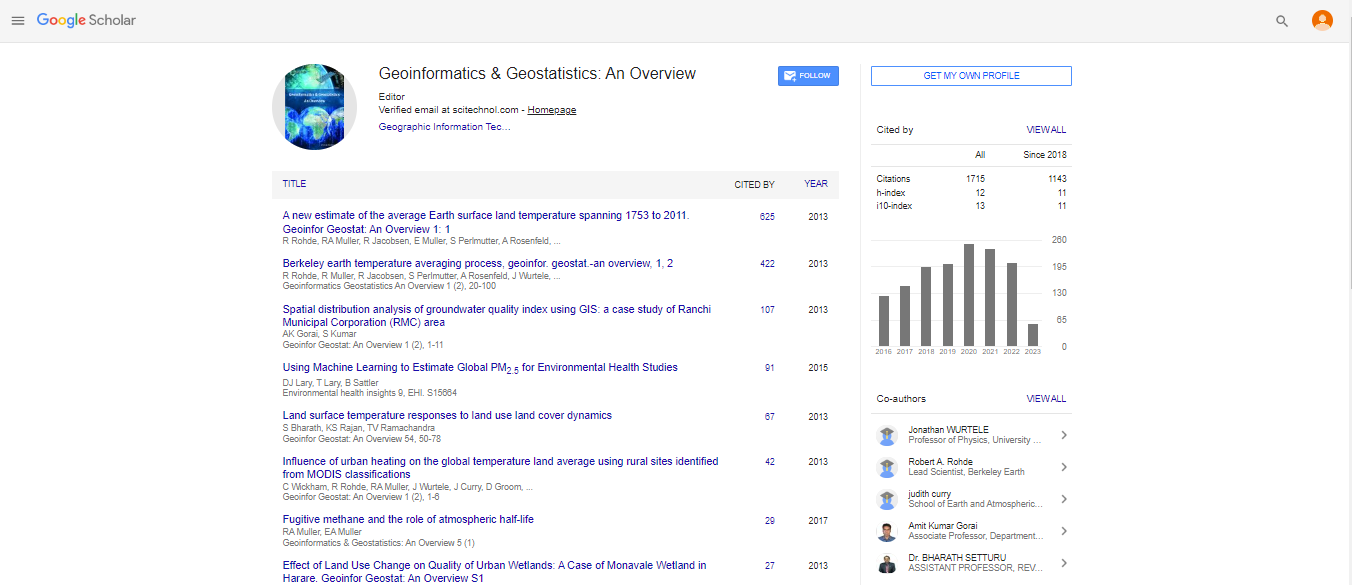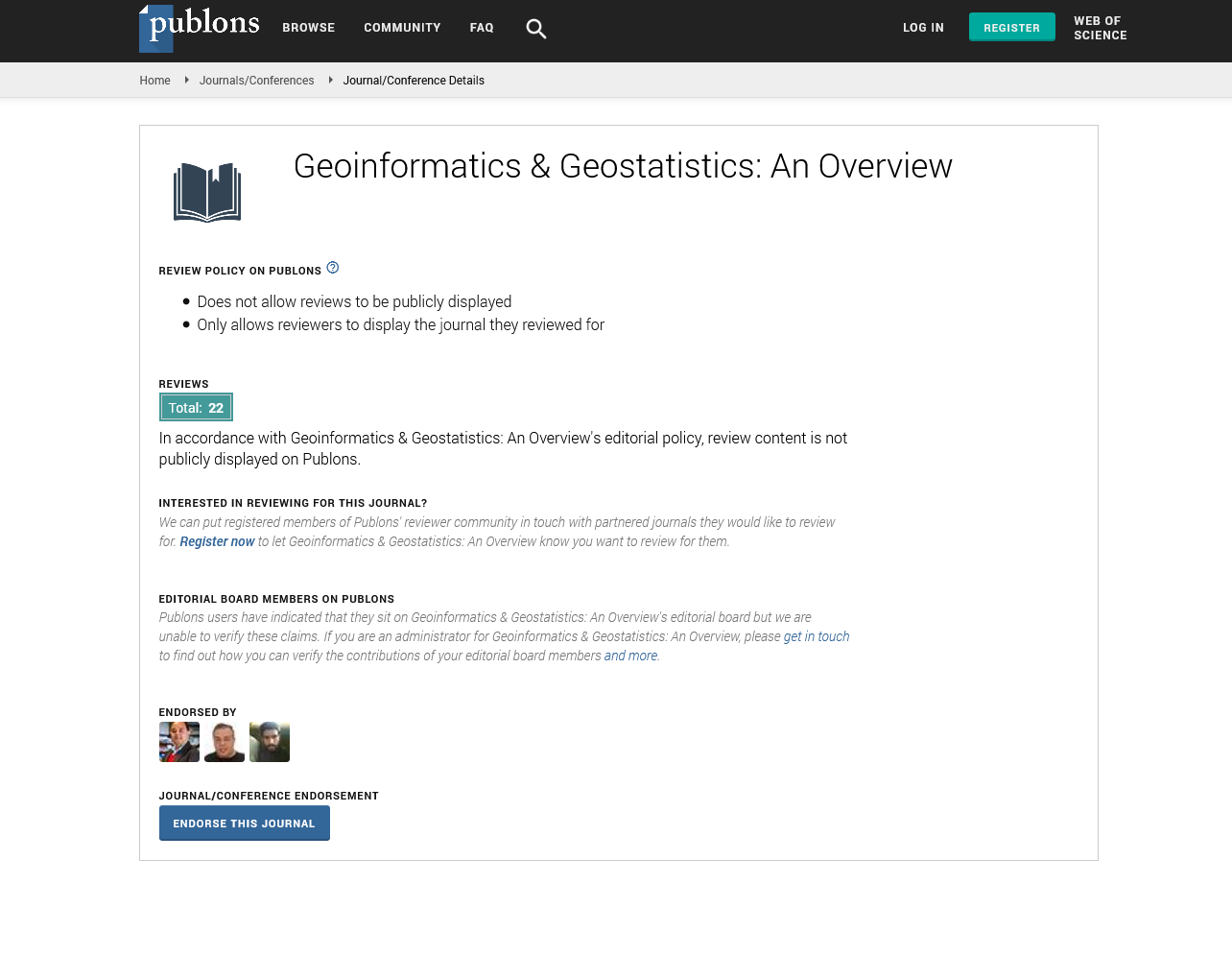Commentary, Geoinfor Geostat An Overview Vol: 12 Issue: 5
Integrating Remote Sensing and Geostatistics for Land Cover Change Detection
Ruisha Hassan*
1Department of Geostatistics, University of Cairo, Cairo, Egypt
*Corresponding Author: Ruisha Hassan,
Department of Geostatistics, University of Cairo, Cairo, Egypt
E-mail: hruisha@cudg.edu.eg
Received date: 23 September, 2024, Manuscript No. GIGS-24-150363;
Editor assigned date: 25 September, 2024, PreQC No. GIGS-24-150363 (PQ);
Reviewed date: 09 October, 2024, QC No. GIGS-24-150363;
Revised date: 16 October, 2024, Manuscript No. GIGS-24-150363 (R);
Published date: 23 October, 2024, DOI: 10.4172/2327-4581.1000417
Citation: Hassan R (2024) Integrating Remote Sensing and Geostatistics for Land Cover Change Detection. Geoinfor Geostat: An Overview 12:5.
Description
Integrating remote sensing and geostatistics for land cover change detection has become an essential approach in environmental monitoring and resource management. As our planet undergoes rapid changes due to urbanization, agriculture and climate shifts, understanding land cover dynamics is vital for sustainable development. Remote sensing provides the means to capture extensive spatial data over large areas, while geostatistics offers robust methods for analyzing this data to discern patterns and trends. Together, they create a powerful framework for assessing land cover changes over time.
Remote sensing involves gathering information about an area from a distance, typically using satellites or aerial imagery. This technology captures various characteristics of the land surface, including its spectral, spatial and temporal features. Sensors aboard satellites like Landsat, Sentinel and MODIS provide valuable data, allowing researchers to monitor land cover changes over extended periods. The ability to capture large-scale environmental changes in a systematic and repeatable manner is one of the significant advantages of remote sensing. It facilitates the observation of phenomena that would be challenging to assess through ground-based surveys alone.
Geostatistics, on the other hand, focuses on analyzing spatially correlated data. It employs statistical techniques to evaluate spatial variability and create models that explain and predict spatial patterns. Key methods include kriging, variograms and spatial interpolation, which allow researchers to understand the distribution of land cover types and their changes. By incorporating spatial relationships into analysis, geostatistics enhances the interpretation of remote sensing data, providing insights into the processes driving land cover changes.
The integration of these two disciplines involves a systematic process. First, high-resolution remote sensing imagery is acquired to capture the current land cover state. This imagery may be complemented by historical data to analyze trends over time. The next step is preprocessing the remote sensing data, which includes atmospheric correction, geometric correction and noise reduction, ensuring accuracy and reliability.
Once the data is prepared, classification techniques are employed to categorize land cover types. Both supervised and unsupervised classification methods are used, with machine learning algorithms increasingly becoming popular due to their enhanced accuracy. After classification, geostatistical methods come into play. Techniques such as variogram analysis help quantify spatial autocorrelation, while kriging allows for predictions in unsampled areas, further enriching the analysis.
Change detection follows this classification process. By comparing classified images from different time periods, researchers can identify areas of change and assess the extent of land cover dynamics. Geostatistical methods can refine this analysis by providing statistical significance to the changes observed, adding depth to the findings. The applications of integrating remote sensing and geostatistics are vast and impactful. In urban planning, this approach can monitor urban sprawl and its implications for green spaces and infrastructure. In agriculture, it aids in assessing crop patterns, enabling more efficient resource management and planning. Additionally, in ecological studies, this integration is important for tracking habitat loss and fragmentation, contributing to conservation efforts.
One notable example of this integration's success is the monitoring of deforestation in the Amazon rainforest. Remote sensing data enabled researchers to pinpoint areas experiencing significant tree loss, while geostatistical techniques provided insights into the spatial distribution of these deforestation hotspots. This information is invaluable for policymakers working to implement effective conservation strategies.
The benefits of integrating remote sensing and geostatistics are manifold. First, the accuracy of land cover classification and change detection improves when the strengths of both fields are combined. Geostatistics quantifies uncertainty, enhancing the reliability of results. Moreover, this integration facilitates a deeper understanding of spatial relationships and trends, offering insights into the factors driving land cover changes.
Another advantage is scalability; remote sensing can analyze vast areas, while geostatistical methods allow for detailed local assessments. This combination is particularly beneficial for studies that require both broad overviews and localized insights. Finally, this integration supports informed decision-making for policymakers and land managers by providing comprehensive data on land cover dynamics, which is important for sustainable land use planning and environmental management.
In conclusion, the integration of remote sensing and geostatistics for land cover change detection represents a significant advancement in environmental monitoring and management. This collaborative approach enhances the accuracy and depth of analyses, providing a better understanding of land cover dynamics. As technology continues to evolve, the synergy between these fields will play an increasingly critical role in addressing global environmental challenges and fostering sustainable practices. By utilizing the capabilities of both remote sensing and geostatistics, we can improve our comprehension of the complexities of our changing world and work toward a more sustainable future.
 Spanish
Spanish  Chinese
Chinese  Russian
Russian  German
German  French
French  Japanese
Japanese  Portuguese
Portuguese  Hindi
Hindi 
